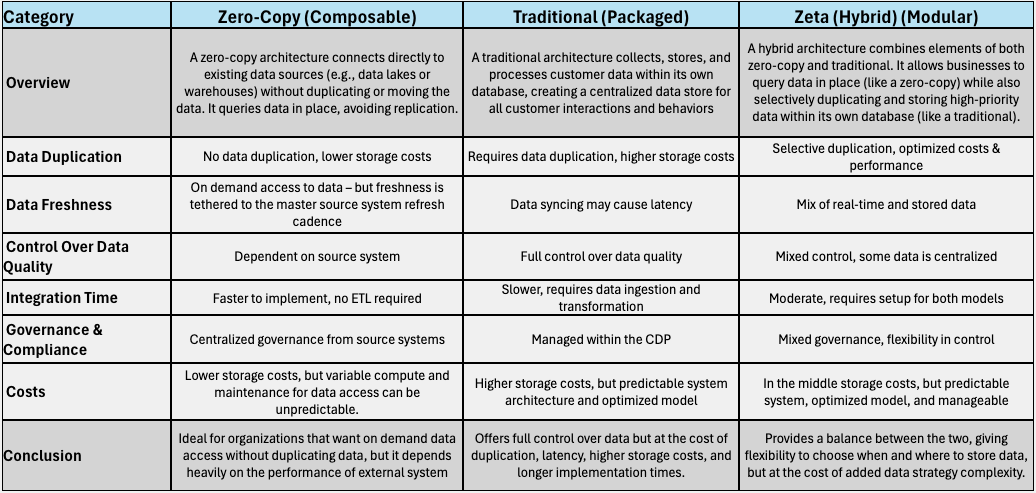
Modular CDP: The Future of Customer Data Management
The CDP industry has become increasingly fragmented over the past few years—which makes it increasingly difficult to understand which solution best meets your business’ needs.
Composable CDPs and Packaged CDPs are well established terms in marketing vocabulary, so most brands start off the decision-making process by asking:
- Do I want a more traditional packaged CDP?
- Or do I want a more custom composable CDP?
But this is a false dichotomy that can derail your CDP decision from the get go.
Enter the Modular CDP—a hybrid architecture that combines the best elements of both packaged and composable solutions while eliminating their key drawbacks.
Rather than forcing you to choose between technical control and operational efficiency, modular CDPs offer a clear path forward for enterprises seeking sustainable growth in their customer data capabilities.
In this post, we’ll explore the components of a CDP, the key differences between Packaged, Composable, and Modular CDPs, and why the hybrid, modular approach is the best choice for most enterprise brands.

Packaged CDPs: Turn-Key Solutions with Limited Flexibility
When you think of a CDP, you’re probably thinking of a more traditional, packaged CDP.
All of the necessary CDP functionality (ingestion, cleansing, enrichment, etc.) comes packaged as a ready-made solution optimized for specific use cases—including pre-defined features, tools, and integrations that make implementation fast and straightforward. This helps you get up and running quickly with minimal development effort.
A traditional packaged CDP architecture collects, stores, and processes customer data within its own database, creating a centralized data store for all customer interactions and behaviors. While this approach allows for full control over data quality, it requires data duplication, which results in higher storage costs compared to a composable CDP.
The primary advantage of a packaged CDP is ease of use, including user-friendly interfaces and simplified data management. Drawbacks include:
- Inherent rigidity. Pre-defined structures and limited customization can create frustrating constraints. Marketers often find themselves restricted by predetermined data models and functionality, which may not align perfectly with their unique business needs and specific strategies.
- Cannot be unbundled. This forces companies to pay for features they might not want or use. This can increase costs and lengthen the window for meaningful ROI.
Composable CDPs: Custom Solutions that Introduce Complexity
Businesses that want more flexibility in their customer data management often consider a composable CDP.
A composable CDP is a set of disparate, unbundled software components that provide the various pieces of CDP functionality—integrated to meet the specific needs of the business. For example, your business may choose to implement one product for data cleansing and another product for data analytics and activation.
Creating a composable CDP requires a microservices architecture, which breaks down software applications into smaller, modular components that can be combined as needed. Also called a zero-copy architecture, these CDPs connect directly to existing data sources (e.g., data lakes or warehouses) without duplicating or moving the data. It queries data in place, avoiding replication and associated storage costs. Composable CDPs are usually managed by the company’s central IT teams as a universal repository intended to serve multiple purposes.
The primary upside to composable CDPs is the high degree of flexibility.
But that flexibility comes with some significant drawbacks to composable CDPs:
- Unnecessary complexity. While the overall marketing technology stack benefits from composability—allowing different functional systems to connect and work together—implementing composability at the component level creates unnecessary complexity and technical debt. This is particularly true for CDPs, where component-level composability can impair critical functions needed for customer data management and activation (like real-time personalization).
- Significant technical requirements. Building and maintaining a composable CDP requires significant technical resources to select and integrate the right components. This process can be both complicated and fraught, especially for businesses with many stakeholders.
- Multiple vendor relationships. Composable CDPs require you to integrate various components from third-party point solutions. This means managing multiple vendor relationships and ensuring that all the different components work together seamlessly. Not only is this time-consuming and resource-intensive, it can also cause data latency which is a big problem when delivering personalized experiences in real time.
- Not all data is suited for living in the data warehouse: Customer behavioral data, for example, can become stale within minutes, which makes it a poor candidate for warehousing.
- Not dedicated to marketing. Architectural decisions are often made by IT in consideration of the entire system’s needs, which may not always prioritize customer experience or marketing program requirements.
Modular CDPs: A Hybrid Approach with the Best of Both Worlds
David Raab, Founder and CEO of The CDP Institute, explains that as composable CDPs have caught buyers’ interest over the past couple of years, traditional packaged CDPs quickly caught on to the demand—and began splitting their offerings into modules. In response, composable CDP vendors have started to offer multiple components and a complete set of CDP functions.
As packaged and composable CDPs grapple for market share, a new type of CDP has emerged: the modular CDP.
A modular CDP offers a hybrid approach that blends the best elements of both packaged and composable solutions. It gives marketers the freedom to customize the functionality in their CDP while still providing a user-friendly interface that streamlines data management and marketing operations.
This hybrid solution not only offers the flexibility needed to adapt to evolving business needs and strategies, but also ensures ease of use for marketers across various skill levels.
“
The benefits of modular CDPs include:
- Implement only the capabilities you need. Unlike Packaged CDPs that come with a fixed set of features, modular CDPs allow you to selectively activate components that are essential to your specific requirements.
- Optimized for higher performance and lower cost. The modular CDP architecture allows businesses to query data in place (like a composable CDP) while also selectively duplicating and storing high-priority data within its own database (like a packaged CDP)—for optimized costs and performance.
- Optimized implementation and time to value. You can start seeing the benefits of your investment sooner, as they are built to enable quick and streamlined implementations with minimal technical resources.
- Pre-built integrations. Include out-of-the-box integrations with popular marketing and sales tools without the need for custom development, which reduces the risk of errors and data inconsistencies.
- Flexible data models. Create and modify custom data models that wrap around your existing technology—and accommodate changing customer data structures and marketing strategies.
- Dedicated support. Implementation and issue support, as well as value-added strategic services, are included—so you have access to dedicated resources that can help you get the most out of your CDP solution.
Zeta’s Modular CDP: A Flexible and Scalable Solution for Managing and Activating Customer Data
Zeta’s Modular CDP was designed based on the belief that creating better segments and driving better decisions requires the CDP to connect directly to the data warehouse AND manage real-time data (like behavioral data).
Our flexible approach allows you to choose the CDP modules and features that best suit your needs—from integration, hygiene and unification to enrichment, identity resolution and more.
- Customize your CDP with your customer experience and marketing programs at the core—while still providing a user-friendly interface that simplifies data management and marketing operations.
- Connect any data source, configure business rules, and manage data flows using a low-code visual interface that puts marketers in the driver’s seat (and reduces the burden on IT teams).
- Access on-demand data faster with pre-built integrations and real-time data sharing with Snowflake® and Google BigQuery™.
- Use our flexible data model to wrap around your existing technology stack, maximizing the value of your current investments and making the most of your data—without a complete overhaul of your tech stack.
Learn more about Zeta’s Modular CDP today.
Want to see Zeta in action?




